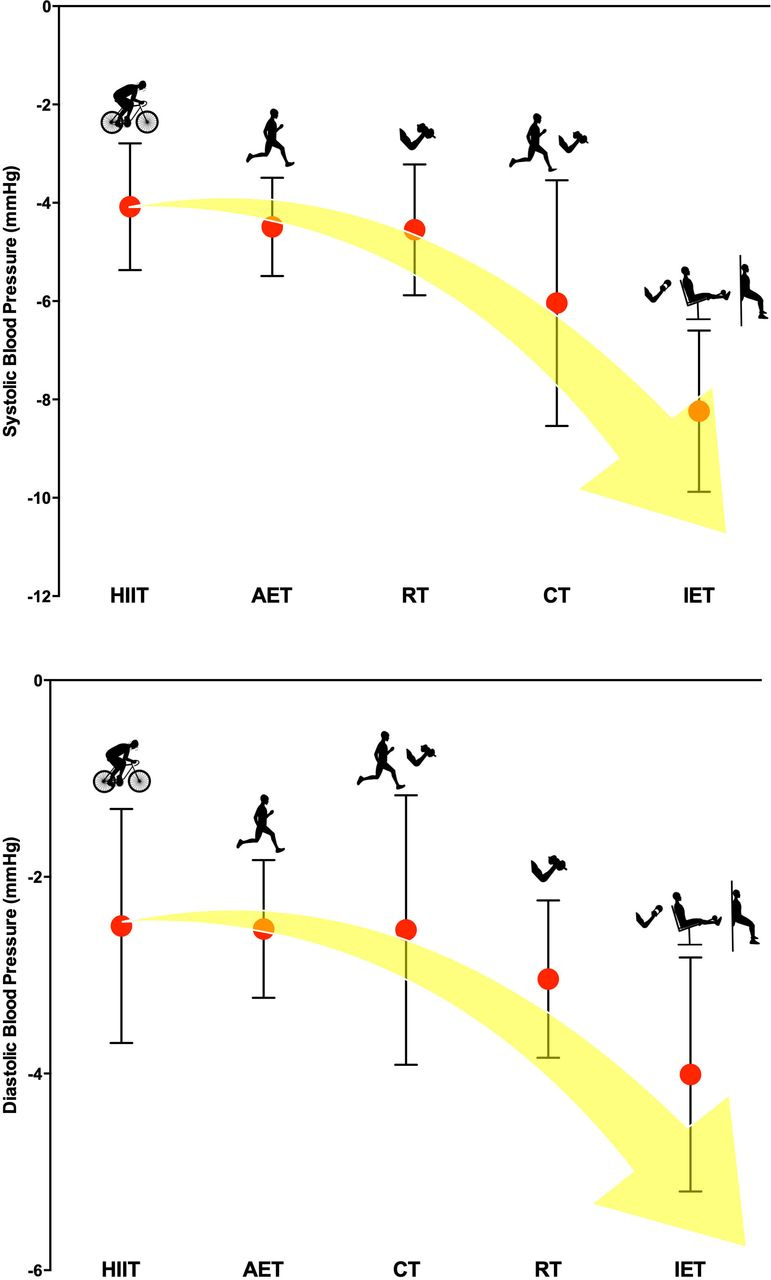Physiology Friday #176: The Best Types of Exercise for Reducing Blood Pressure
Which workout has the greatest antihypertensive effects?
Greetings!
Welcome to the Physiology Friday newsletter.
As always, the sponsors can be found at the end of this newsletter.
Cardiovascular disease kills more people worldwide than any other noncommunicable disease.
Hypertension — also known as high blood pressure — is one of the leading modifiable risk factors for cardiovascular disease and a host of other complications. In short: the higher your blood pressure, the worse off you’ll be.
One of the best nonpharmacological strategies to reduce blood pressure is exercise. The most-often prescribed exercise for blood pressure reduction is aerobic exercise such as running, walking, and cycling.
Though aerobic exercise has dominated research and medical practice, little is known about whether this mode of exercise is optimal for blood pressure reduction. Do other types of exercise training such as resistance training, high-intensity interval training (HIIT), and combined aerobic and resistance training also improve blood pressure to a similar degree as aerobic exercise?
In a recently-published network meta-analysis in the British Journal of Sports Medicine (BJSM)1, the effects of different types of exercise training on resting blood pressure were investigated and put head-to-head in a comparison of their antihypertensive effects.
A total of 270 randomized controlled exercise training studies were included in the meta-analysis, involving 15,827 participants.
A total of five different exercise modes were included: aerobic exercise training, dynamic resistance training, combined training, HIIT, and isometric exercise training.
In addition, exercise “subgroups” were identified within each exercise mode:
Aerobic exercise training: walking, running, and cycling
HIIT: sprint interval training (“all out” efforts) and aerobic interval training (e.g., 4x4 intervals)
Isometric exercise training: isometric handgrip exercise, isometric leg extension, isometric wall squats
Participants were stratified by baseline blood pressure into normotension (<130/85 mmHg), prehypertension (130–139/85–89 mmHg), and hypertension (>140/90 mmHg).
Results
All modes of exercise were effective for reducing systolic blood pressure and diastolic blood pressure compared to control (non-exercise) interventions. Specifically:
Aerobic exercise training reduced SBP by 5 mmHg and DBP by 3 mmHg
Walking reduced SBP by 3 mmHg and DBP by 1 mmHg
Cycling reduced SBP by 7 mmHg and DBP by 3 mmHg
Running reduced SBP by 7 mmHg and DBP by 6 mmHg
Resistance training reduced SBP by 5 mmHg and DBP by 3 mmHg
Combined training reduced SBP by 6 mmHg and DBP by 3 mmHg
HIIT reduced SBP by 4 mmHg and DBP by 3 mmHg
Sprint interval training reduced SBP by 5 mmHg and DBP by 3 mmHg
Aerobic interval training did not reduce SBP or DBP
Isometric exercise reduced SBP by 8 mmHg and DBP by 4 mmHg
Handgrip exercise reduced SBP by 7 mmHg and DBP by 4 mmHg
Isometric leg extension reduced SBP by 10 mmHg and DBP by 4 mmHg
Isometric wall squats reduced SBP by 11 mmHg and DBP by 5 mmHg
All exercise modes reduced SBP in people with normal blood pressure, however, the blood-pressure-lowering effects were greater in participants who had hypertension.
Ranking exercise modes
One novel component of this study was the inclusion of a network meta-analysis. This statistical technique allows different interventions (in this case, different types of exercise) to be compared to one another and ranked in terms of their probability for improving an outcome (in this case, blood pressure).
Systolic blood pressure
When each exercise mode was ranked in terms of their effectiveness isometric exercise was the most likely to be effective, followed by combined training, resistance training, aerobic exercise training, and HIIT.
Isometric exercise was more effective for reducing SBP compared to aerobic exercise (by 4 mmHg), HIIT (by 4 mmHg), and resistance training (by 4 mmHg).
When exercise subgroups were ranked for their effectiveness, isometric wall squats were most likely to be effective, followed by isometric leg extension, isometric handgrip exercise, cycling, running, combined training, sprint interval training, resistance training, aerobic interval training, and walking.
Diastolic blood pressure
Isometric exercise training was most likely to be effective, followed by resistance training, HIIT, combined training, and aerobic exercise training.
When exercise subgroups were ranked, running was most likely to be effective, followed by isometric wall squats, isometric handgrip exercise, isometric leg extension, cycling, sprint interval training, resistance training, aerobic interval training, combined training, and walking.
The authors of this study note that these findings warrant “a need for an exercise recommendation guideline update.”
Indeed, the finding that HIIT, in addition to all other exercise types, was effective for reducing blood pressure means that exercise prescription for hypertension management can (and should) involve several modes of exercise, not just aerobic.
One novelty of this study was the additional analysis of exercise subgroups, which revealed cycling and running to be the most effective types of aerobic training (vs. walking), and sprint interval training to be more effective than aerobic interval training (which was ineffective) for blood pressure reduction. This may indicate that higher-intensity training produces the greatest blood pressure reductions.
It might seem surprising that resistance exercise training and isometric exercise training (a type of exercise that doesn’t involve muscle length changes or joint movement, only the application of force) were highly effective for reducing blood pressure, even more so than aerobic training in some instances.
Why might resistance and isometric exercise be so effective?
These types of exercise are likely to cause the greatest increase in blood pressure during the exercise when muscles are contracted, the core is braced, and blood flow to certain areas of the body is reduced due to vasoconstriction.
However, the drop in blood pressure after exercise is also larger in magnitude. This is a phenomenon known as post-exercise hypotension and occurs after all types of exercise due to the release of vasodilating substances and an increase in blood flow, among other factors. A greater post-exercise hypotensive response to isometric and resistance exercise (as well as HIIT) could explain the superior ability of these modes to reduce resting blood pressure.
How can you apply these findings?
Whether you have hypertension or not, it seems that all types of exercise can help with blood pressure management. The good news is that anything you do will help.
Combining different modes of exercise — for example, a training regimen that includes some aerobic training, some HIIT, some resistance training, and some isometric training — is likely the optimal prescription for blood pressure management/reduction. Aside from the benefits for blood pressure, this type of training regimen will also target all aspects of cardiometabolic health, strength, and physical function.
Though certain exercises were found to be superior to others in this study, the magnitude of the blood pressure changes, which ranged from 3 to 8 mmHg, were similar for most types of exercise evaluated.
Thus, I can’t end this article with a snippy line about how running is the best type of exercise or how “cardio is king.” Rather, I have to stick with the old party line of “do a bit of everything”, for that seems to be the path to optimal health.
Thanks for reading. See you next Friday.
~Brady~
Examine.com: Examine is the largest database of nutrition and supplement information on the internet.
PodScholars: PodScholars is the first podcasting platform and database specifically geared towards published research, where scholars, researchers, and other experts can broadcast published science as audio or video casts.












Another great column. Question: are there instances/conditions in which exercise (of any kind, like listed here) does NOT lower BP? Asking for a friend...
Thanks Brady, I appreciate the work you do researching exercise results on health problems. I'm curious if you know more research on Exercise With Oxygen therapy (EWOT). I read William Campbell Douglass' MD book Stop Aging or Slow the Process using EWOT published in 2003.
I bought an oxygen concentrator to use when I ride the stationary bike to experiment myself. I've had it for two weeks so my hands-on research has just started. Do you have any insight on EWOT?
Thanks so much.